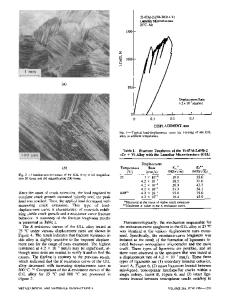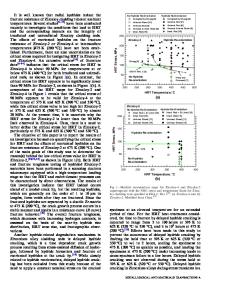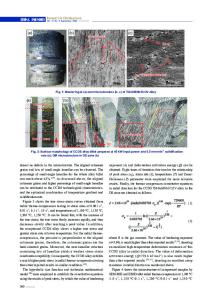The fracture resistance of a binary TiAl alloy
- PDF / 4,404,036 Bytes
- 10 Pages / 612 x 792 pts (letter) Page_size
- 8 Downloads / 321 Views
I. INTRODUCTION
RECENT advances in TiAl alloy development have led to a number of two-phase a2 1 g alloys that can be heat treated to a variety of microstructures, including the equiaxed, duplex, and fully lamellar microstructures, that exhibit attractive mechanical properties for aerospace applications.[1–6] Of the various microstructures, the fully lamellar microstructure exhibits the highest resistance against crack growth under both monotonic[7–21] and cyclic loading conditions.[2,6,22–31]. Much of the fracture resistance in the lamellar material arises from ligament bridging toughening[8] that is more prevalent under monotonic loads[7,8,10–13,14–16,18,19] than under cyclic 1oads.[28,29] The ligament bridging toughening mechanism relies on the presence of intact ligaments in the crack’s wake. Any microstructural changes that affect the formation or destruction of the crack-wake ligaments influence the fracture resistance of the alloys. The volume fraction and size of the lamellar colonies, as well as the spacing of the lamellae within individual colonies, have been shown to affect the fracture resistance of TiAl alloys by virtue of their influence on the ligament formation and destruction process.[16,18] Most of the fracture studies on TiAl alloys have focused on systems containing multiple alloying elements, e.g., Cr, V, Nb, Mn, W, and, among others, C, B, and Si.[1,2] One of the most studied TiAl alloys is perhaps the GE Ti-47Al2Nb-2Cr quaternary alloy.[5,6,28,29] Substantial work has been done on Ti-47Al-xNb-yCr-zV quinary alloys, where x, y, and z range from 1 to 3 pct.[3,4,7,8,10,11,13–16,18] Only a few studies have focused on the fracture behavior of binary TiAl KWAI S. CHAN, Institute Scientist, is with the Southwest Research Institute, San Antonio, TX 78238. JESSICA ONSTOTT is former Graduate Student, Division of Engineering, Brown University, Providence, RI 02912. K. SHARVAN KUMAR, Professor, is with the Division of Engineering, Brown University. Manuscript submitted October 29, 1998.
METALLURGICAL AND MATERIALS TRANSACTIONS A
alloys[32,33] or PST TiAl.[34] Mitao et al.[32] studied the fracture toughness of binary as-cast TiAl alloys with Al contents in the range of 44 to 51 at. pct using the ASTM-E399 standard procedure.[35] The highest fracture toughness among the alloys studied was '30 MPa!m, which was observed in Ti-48Al with the lamellar microstructure. This toughness value was calculated based on the critical load, PQ , measured from the load-displacement curve. Subsequent work on the effect of colony orientation identified the existence of fracture anisotropy in PST TiAl[34] and binary TiAl alloys.[33] The general characteristics of the fractographic features, crack path morphology, and fracture anisotropy in PST TiAl[34] and binary alloys[33] were similar to those in quaternary or quinary TiAl alloys containing multiple alloying additions. As a result, it has been generally tacitly assumed that the fracture behavior of TiAl alloys with the lamellar microstructure are similar, regardless of a
Data Loading...











